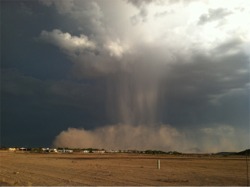
Introduction:
From the discussions on the newsgroup sci.geo.meteorology this is a collection of some formulae and texts that reflect on connections of temperature, humidity and dew point temperature:
Air will normally contain a certain amount of water vapor. The maximum amount of water vapor, that air can contain, depends on the temperature and, for certain temperature ranges, also on whether the air is near to a water or ice surface. If you have a closed con- tainer with water and air (like a beaker) then there an equilibrium will develop, where the air will contain as much vapor as it can. The air will then be saturated with respect to water vapor. The real world outside is not closed, so that the air normally will contain less vapor as it could. Sources of vapor are evaporation processes from water and ice surfaces and transpiration from plants and respiration from animals. The expression "evapotranspiration" takes into consideration plants' large share of evaporation over land areas.
Sinks of water vapor are clouds or condensation on surfaces. Dew is created when a surface temperature has such a low temperature that the air chills to the dew point and the water vapor condenses. Physically at the dew point temperature the vapor loses the energy that it gained at evaporation, the latent energy, again.
The precipitable water (total column water vapor) is strongly correlated (r > 0.9) with the surface dew point on most days. Exceptions to the rule include days when a cold front has passed and during other transient events. (Kerry Andersen)
Reference
http://stuff.mit.edu/afs/athena/project/weather/INFO/Frequently_Asked_Questions-temp-dewpoint
------------------------------------------------------------------------------
Air Density calculated from: Dry Bulb Temperature
Pressure
------------------------------------------------------------------------------
Rho = P / (R * T)
where:
P = Barometric pressure (mB * 100 to get Pa)
Rho = Air Density
R = 287.05 (Gas Constant)
T = Dry Bulb Temperature (C)
------------------------------------------------------------------------------
Dewpoint calculated from: Dry Bulb Temperature
Relative humidity
Barometric Pressure
------------------------------------------------------------------------------
Es = 6.1078 * 10^((7.5 * T) / (237.3 + T))
E = (RH/100) * Es
RH = 100 * (E / Es)
D = (T-(14.55+0.114*T)*(1-(0.01*RH))-((2.5+0.007*T)*(1-(0.01*RH)))^3-(15.9+0.117*T)*(1-(0.01*RH))^14)
W = (((0.00066*P)*T)+((4098*E/(D+237.3)^2)*D))/(0.00066*P)+(4098*E/(D+237.3)^2))
where:
W = Wet Bulb Temperature in Centigrade (C) degrees
P = Barometric Pressure in millibars (mb)
Es = Saturation Vapor Pressure at Dry Bulb (mb)
Ew = Saturation Vapor Pressure at Wet Bulb (mb)
Ed = Saturation Vapor Pressure at Dew Point (mb)
E = Actual vapor Pressure at Ambient
B = intermediate value (no units)
RH = Relative Humidity in percent (%)
D = Dewpoint in Centigrade (C) degrees
e^ = natural log (e to the power of...)( or 2.718281828^ )
6.1078 = reference saturation vapor pressure (Es at a certain temp, usually 0 deg C)
237.3 = vapor pressure constant with respect to water
7.5 = constant for vapor pressure
Other Formulae
Ew = 6.1078 * (e^((17.27 * W) / (237.3 + W)))
E = Ew - (0.00066 * (1 + 0.00115 * W) * (T - W) * P)
Ed = 6.1078 * 10^((7.5 * Td)/(237.7 + Td))
D = (P / (278.05 * T)) * (1-((0.378 * E) / P) <- Disappointed in this one, flat line
Es = eso / p^8
where: Es = saturation pressure of water vapor, mb
eso=6.1078
p = (c0+T*(c1+T*(c2+T*(c3+T*(c4+T*(c5+T*(c6+T*(c7+T*(c8+T*(c9))))))))))
T = Dry Bulb temperature, deg C
c0 = 0.99999683
c1 = -0.90826951*10-2
c2 = 0.78736169*10-4
c3 = -0.61117958*10-6
c4 = 0.43884187*10-8
c5 = -0.29883885*10-10
c6 = 0.21874425*10-12
c7 = -0.17892321*10-14
c8 = 0.11112018*10-16
c9 = -0.30994571*10-19
------------------------------------------------------------------------------
Dewpoint calculated from: Dry Bulb Temperature
Relative Humidity
-----------------------------------------------------------------------------
B = (ln(RH / 100) + ((17.27 * T) / (237.3 + T)))
D = (237.3 * B) / (17.27 - B)
where:
T = Air Temperature (Dry Bulb) in Centigrade (C) degrees
RH = Relative Humidity in percent (%)
B = intermediate value (no units)
D = Dewpoint in Centigrade (C) degrees
* = multiply by...
e^ = natural log (e to the power of...)
------------------------------------------------------------------------------
Barometric Pressure calculated from Elevation
-----------------------------------------------------------------------------
P = 101.3 * ((( 293 - ( 0.0065 * E )) / 293 ) ^ 5.26 )
where:
E = Elevation in meters (m)
P = Barometric Pressure in millibars (mb)
* = multiply by...
^ = to the power of
------------------------------------------------------------------------------
Tower Efficiency
-----------------------------------------------------------------------------
The cooling tower efficiency can be expressed as
μ = (ti - to) 100 / (ti - to) + (ti - twb)
where
μ = cooling tower efficiency - common range between 70 - 75%
ti = inlet temperature of water to the tower (oC, oF)
to = outlet temperature of water from the tower (oC, oF)
twb = wet bulb temperature of air (oC, oF)
------------------------------------------------------------------------------